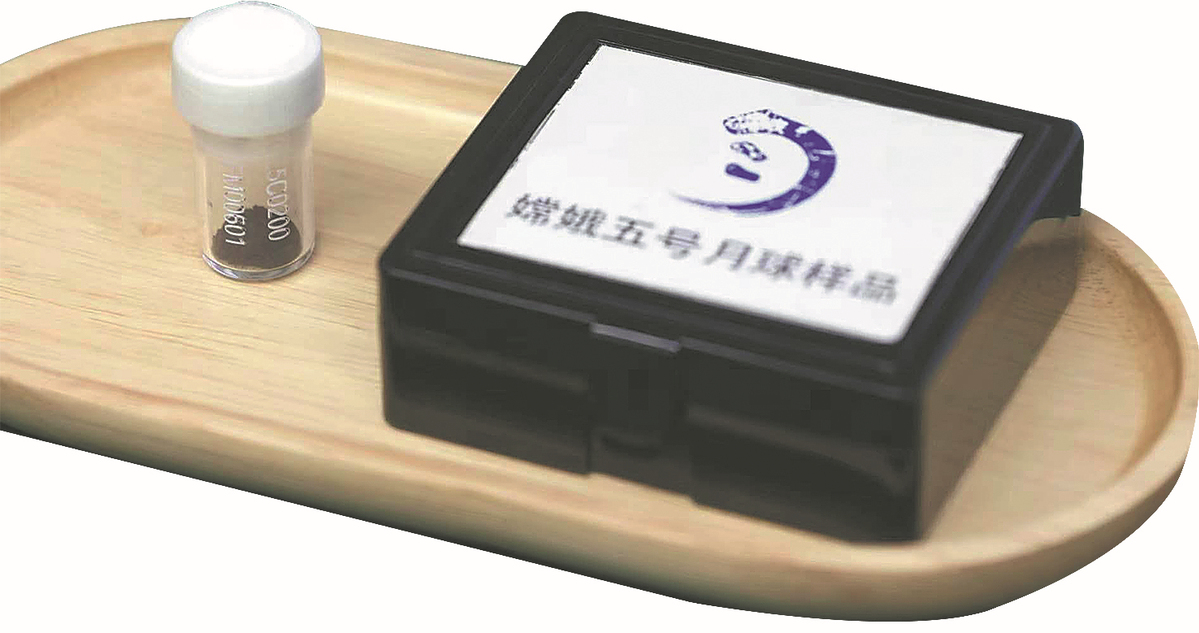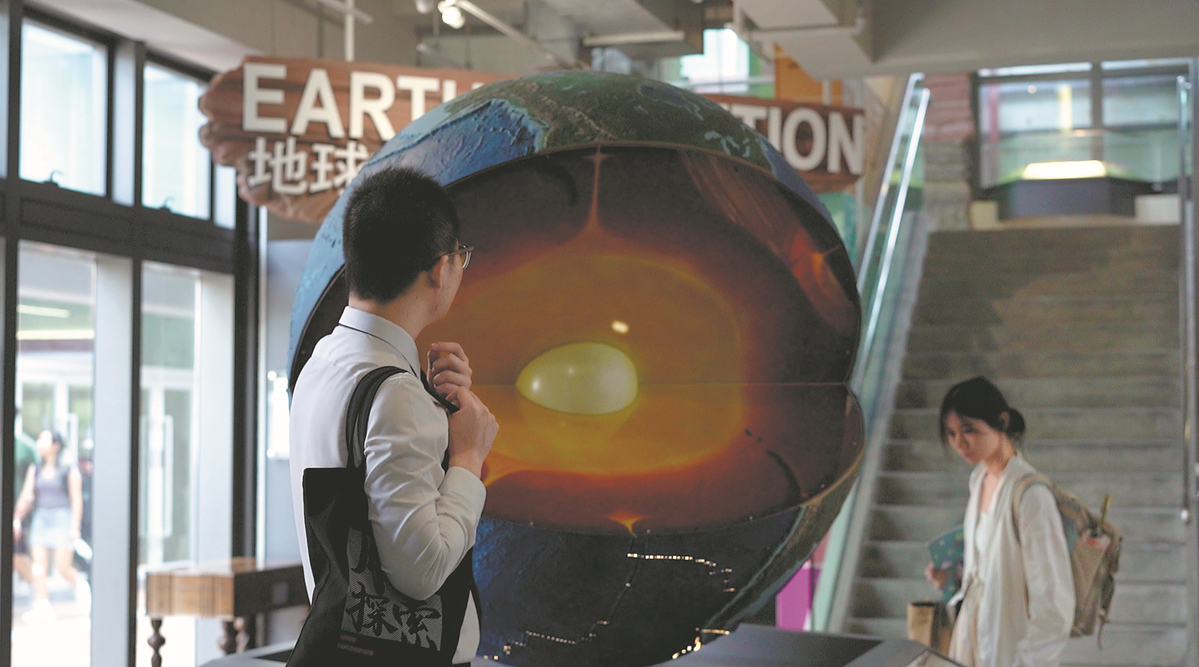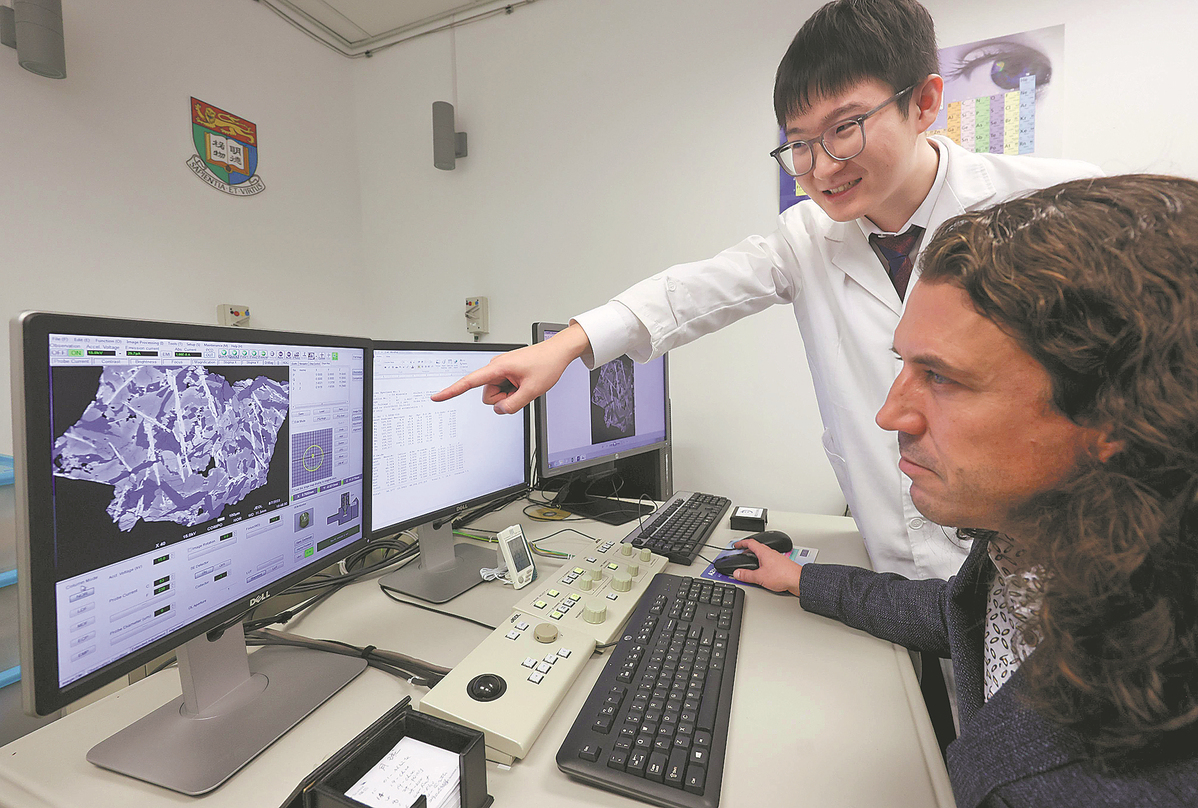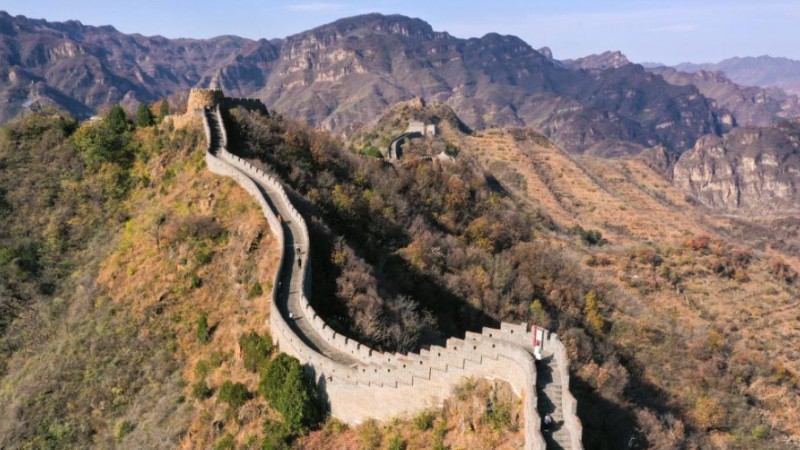HK, Macao add thrust to nation's space exploration

Lunar soil samples collected by the Chang'e 5 probe are displayed at the University of Hong Kong. [CALVIN NG/CHINA DAILY]
Both cities make significant contributions to research
Many people gazing at the moon shining brightly in the night sky wonder what secrets the Earth's satellite holds.
However, few of them have the chance to access lunar soil and study it to unlock such mysteries, unlike Qian Yuqi.
At the start of this year, Qian, a postdoctoral fellow from the Department of Earth Sciences at the University of Hong Kong, or HKU, applied to access lunar soil samples from the China National Space Administration. His application was approved in June.
It was the first time Hong Kong had secured lunar soil samples for study.
Although he is only 28, Qian, a geologist who wears dark glasses and sports a flat haircut, has been studying the moon for nearly a decade.
His enthusiasm for all things lunar runs deep. His computer desktop boasts a screen saver showing the moon. He carries a backpack displaying the Chinese characters for "moon exploration", and a model of the moon sits on his office desk. Qian also repeatedly emphasizes just how interesting his lunar studies are.
Qian's interest in space dates to his childhood. While immersing himself in science fiction films and novels, he noticed that these stories were always set in space, with geologists playing significant roles.
After passing the college entrance examination in 2013, Qian pursued a degree in geology at China University of Geosciences (Wuhan) in Hubei province. He could only choose a major centered on the Earth's geology, as no undergraduate programs on the mainland at that time were specifically focused on planetary science or deep space exploration, he said.
Qian worked hard, as he knew that studying the Earth's geology could lay a solid foundation for exploring other planets. His opportunity soon arrived, with China's lunar exploration program gaining significant momentum.
In 2004, China officially launched the Chang'e project to explore the moon in three phases to fulfill three aims: unmanned lunar exploration, a manned lunar landing, and establishing a lunar base.
The unmanned lunar exploration, or the Chinese Lunar Exploration Program, also consists of three phases: orbiting, landing and returning.
The orbiting phase, which began in 2004, involved Chang'e 1 in 2007 and Chang'e 2 in 2010 exploring the lunar surface from orbit. The landing phase involved Chang'e 3 in 2013 and Chang'e 4 in 2018 landing on the moon's surface for detailed exploration. The returning phase included the Chang'e 5 mission in 2020, which collected lunar samples for a return to Earth.
When the Chang'e project started, many mainland university researchers switched their research focus to the moon and became involved in these missions.

Visitors view replicas of Chinese rockets at an aerospace exhibition in Wuhan, Hubei province. [CHINA DAILY]
Research role
In May 2011, Qian's university established the Planetary Science Institute, with the aim of spearheading research in lunar and planetary science.
The institute organized a lecture at the university to present its research findings. Qian attended the lecture, finding it deeply interesting. That night, he wrote a letter to a senior professor at the institute, stating that he wanted to contribute to furthering China's space endeavors.
Impressed by Qian's ability and enthusiasm, the professor accepted him as his research student — giving Qian access to national lunar research.
Under his mentor's guidance, Qian conducted a lot of research based on data collected by Chang'e 3 and Chang'e 4. He also supported a prelaunch study for Chang'e 5.
The Chang'e 5 mission team aimed to select the best landing site from a 50,000-square-kilometer preselected zone.
Qian remained in his laboratory for many days, extensively reviewing remote sensing archives of the moon's surface captured by satellites. He discovered the eastern region of the preselected zone may contain basalts that are about 2 billion years old — potentially making subsequent soil collections younger than any previous samples secured by other nations, such as the United States and the former Soviet Union.
Such samples could provide insights into the moon's formative history. Given the similarities between early lunar and Earth environments, this could also help scientists unravel the secrets of the Earth's early history.
Qian released a paper suggesting the landing site for Chang'e 5, stimulating extensive discussion among scientists and the mission team.
Chang'e 5 was due to launch in 2017. However, in July that year, the project experienced a significant setback when the Long March 5 large carrier rocket, which is the main booster of Chang'e 5, failed to lift off.
Engineers swiftly launched an emergency investigation into the cause of the failure.
This was also a distressing time for Qian. "As the Long March 5 was a critical project, the problem had to be tackled quickly. However, the timeline was uncertain, and I found this deeply worrying," he said.
While closely following news reports about the Long March 5 and Chang'e 5, Qian continued his doctorate research at his university, while remaining focused on lunar studies.
The Long March 5 was finally launched in November 2020, taking Chang'e 5 skyward.
The probe landed precisely where Qian recommended, collecting 1,731 grams of samples. In addition, analysis of the soil confirmed Qian's research. The soil is nearly 1 billion years younger than any previous lunar volcanic deposits returned to Earth.

Geoscientist Qian Yuqi inspects a model of the Earth. [FLORENCE LI/CHINA DAILY]
Rental opportunities
Since July 2021, the China National Space Administration, or CNSA, Lunar Exploration and Space Engineering Center has granted eligible organizations the opportunity to rent lunar research samples for related research.
Asked by his mentor to research some soil samples, Qian quickly wrote several papers about them.
In December, Qian completed his doctorate with flying colors. In recognition of his exemplary work, he received the Li Siguang Outstanding Ph. D. Student Award early this year, one of the highest awards for geoscience students in China.
Qian next decided to further his lunar research through a postdoctoral position in HKU's Department of Earth Sciences.
Deep space missions such as lunar exploration demand significant financial and technological capabilities — typically the preserve of nations such as China and the United States, and the European Space Agency.
"Doing research in Hong Kong offers me the opportunity to remain engaged in a national project, further contributing to the country," Qian said.
Researching lunar geology in Hong Kong can also stimulate development of related local industries, inspire young people in the city to take part in this field, and enhance cooperation between Hong Kong and the mainland on deep space exploration, Qian said.
Scholars in Hong Kong studying the moon's geography mostly rely on remote sensing data, rather than direct analysis of lunar soil. "I can use my abilities to fill a gap in this respect," Qian said.
After joining HKU in March — becoming the first at the institution to engage in lunar research — Qian soon started to apply for lunar soil for his work.
Early this year, the CNSA again began accepting applications for lunar samples, and Qian spent a month preparing a proposal, submitting it before the deadline.
A few weeks later, the CNSA phoned him to say his proposal had passed the initial review and would now require an oral defense.
At the end of May, Qian defended his proposal in Beijing, introducing his research ideas, team members, equipment for experiments, and sample storage conditions at his university to the panel of judges.
During the application process, Qian found that lunar science in the country is progressing swiftly. Many top universities now offer undergraduate programs to cultivate expertise in deep space and planetary domains. Their faculty and students, along with researchers from key institutions, are applying to study lunar soil for purposes beyond Qian's volcanology research.

Qian and fellow geoscientist Joseph Michalski examine an image of the lunar soil. [CALVIN NG/CHINA DAILY]
List approved
In June, the CNSA issued the final approved list for borrowing lunar research samples. A total of 60 applications from 23 individuals at 16 research institutions were endorsed. In all, just over 12,328 milligrams of samples have been distributed.
Qian was among the successful applicants — obtaining four lunar samples with a total weight of 822.6 mg. He can borrow them for one year.
At the end of July, Qian traveled to Beijing to collect the samples, but his trip coincided with the arrival of Typhoon Doksuri.
Despite heavy rain caused by the typhoon, the CNSA prepared the samples on time for scholars — preventing any delays in research for those throughout the country who traveled to collect them.
As Qian sat on the train heading back to Hong Kong, rain poured relentlessly, obscuring the view beyond his window. As he continued his journey, he read news on his phone of the escalating casualties caused by the severe downpours.
However, he had no time to worry about his safety, as his attention was firmly focused on the lunar samples. He carefully secured the container inside his backpack in shock-absorbing foam. He held the backpack tightly to try to protect the samples from every vibration and sway of the train.
He finally relaxed only after his 11-hour journey ended and he was back in Hong Kong safely.
"Securing these samples is a dream come true for ourselves and Hong Kong's space science community," Qian said, adding that such acquisition also reflects the central government's commitment to supporting the city.
By granting his request, the central authorities also demonstrated their desire to see Hong Kong develop capabilities in the field of space and keep pace with advances made on the mainland, Qian added.
In the coming year, Qian said he will use the lunar samples to unlock mysteries of the moon's volcanic history, try to provide insights into its geological past, and its connection to the formation and evolution of planetary bodies in the solar system.
Furthermore, he hopes his application will help establish a comprehensive mechanism at HKU for storing lunar samples and conducting research, thus enhancing the city's capacity to take part in future national lunar exploration missions.

Visitors to an exhibition in Hefei, Anhui province, take photographs of an engine retrieved from a Long March 2E rocket. [Photo/XINHUA]
First milestone
Qian said the moon is the first milestone on humankind's journey to exploring the cosmos, adding that China has many lunar exploration plans for the immediate future.
Chang'e 6, scheduled for launch sometime next year, is set to become the first probe to retrieve samples from the dark side of the moon.
In 2026, China plans to launch Chang'e 7 to investigate water resources at the moon's south pole. After this, the nation envisions establishing small bases on the moon. Furthermore, China is aiming for a manned landing on the moon before 2030.
Qian, who is researching the landing site for Chang'e 6, plans to continue obtaining soil samples brought back by the probe. He said he will also try his best to become involved in future national space missions.
Many people in Hong Kong and Macao, such as Qian, are actively contributing to the nation's space exploration efforts.
For example, Macau University of Science and Technology, or MUST, has been involved in data analysis and scientific research for the Chang'e project since 2005.It is the first university in the Guangdong-Hong Kong-Macao Greater Bay Area, or GBA, to be involved in the nation's lunar project.
At the end of 2019, the CNSA announced the establishment of a space exploration and science center at the Macao university to improve the deep level of cooperation between the GBA and international research institutes by using Macao's advantages. In addition, Macao Science 1, the first space science satellite jointly developed by the mainland and Macao, was launched this year.
Meanwhile, Hong Kong Polytechnic University, or PolyU, has made noteworthy contributions to developing hardware to support national space exploration efforts.
In 2013, PolyU collaborated with experts from the China Academy of Space Technology to develop the Camera Pointing System. Despite operating in challenging conditions, this navigation camera was landed on the moon by Chang'e 3 to capture images of the lunar landscape.
The camera was later updated and used again during the Chang'e 4 mission in 2018.
Furthermore, the PolyU team was responsible for developing the device used to sample lunar soil collected by the Chang'e 5 probe in 2020.
That year, PolyU further successfully developed and manufactured the Mars Landing Surveillance Camera, one of the key instruments aboard the spacecraft taking part in the Tianwen 1 mission — the nation's first to the Red Planet.
PolyU also conducted a detailed analysis of the geology and topography of the landing zones for the Chang'e 3 and Chang'e 4 missions, supporting the two probes to find suitable landing sites.
At least three universities in Hong Kong offer undergraduate and master's degree programs for training aerospace personnel, with 100 graduates specializing in aerospace technology each year.
In 2020, selection of the nation's fourth batch of astronauts started, with the process open to applicants from Hong Kong and Macao for the first time. This month, the process reached the final stage, and included several candidates from both cities.
Qian said: "While public attention often focuses on immediate concerns, scientists look farther into the future. Events such as wars, pandemics, climate crises, or outbreaks of superviruses could render Earth inhospitable to life someday, and today's scientific endeavors will contribute to securing humanity's home in the future."
Photos
Related Stories
- Star-studded financial summit lineup casts vote of confidence in Hong Kong, mainland
- Huge blobs in Earth's mantle might be relics from moon-forming collision: study
- Hong Kong teams up with Guangdong, Macao to woo global talents
- Chinese vice premier urges Hong Kong to fully tap advantages
- Macao releases 1st development plan for appropriate economic diversification
- More Macao firms attend CIIE in Shanghai this year
Copyright © 2023 People's Daily Online. All Rights Reserved.









